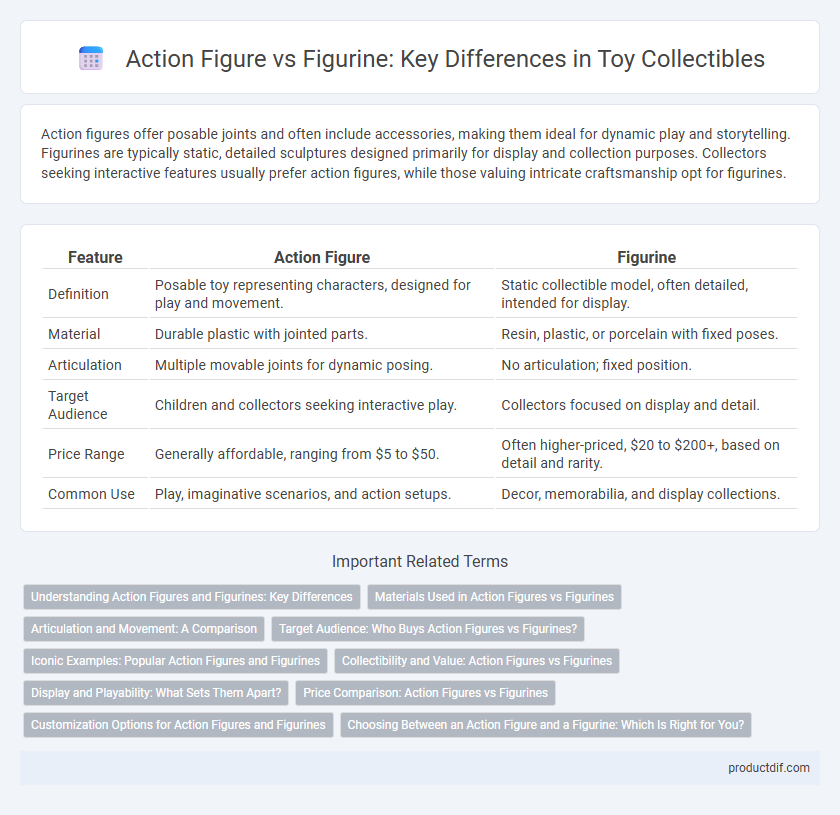Action figures offer posable joints and often include accessories, making them ideal for dynamic play and storytelling. Figurines are typically static, detailed sculptures designed primarily for display and collection purposes. Collectors seeking interactive features usually prefer action figures, while those valuing intricate craftsmanship opt for figurines.
Table of Comparison
| Feature | Action Figure | Figurine |
|---|---|---|
| Definition | Posable toy representing characters, designed for play and movement. | Static collectible model, often detailed, intended for display. |
| Material | Durable plastic with jointed parts. | Resin, plastic, or porcelain with fixed poses. |
| Articulation | Multiple movable joints for dynamic posing. | No articulation; fixed position. |
| Target Audience | Children and collectors seeking interactive play. | Collectors focused on display and detail. |
| Price Range | Generally affordable, ranging from $5 to $50. | Often higher-priced, $20 to $200+, based on detail and rarity. |
| Common Use | Play, imaginative scenarios, and action setups. | Decor, memorabilia, and display collections. |
Understanding Action Figures and Figurines: Key Differences
Action figures are posable toys designed for interactive play, often featuring articulated joints and accessories to enhance imaginative scenarios, primarily targeting children and collectors. Figurines are typically static, detailed sculptures meant for display, emphasizing craftsmanship and aesthetic appeal with limited or no movement. Understanding these distinctions helps consumers choose between play-focused action figures and decorative figurines based on their interests and purposes.
Materials Used in Action Figures vs Figurines
Action figures are typically made from durable plastics like PVC and ABS, which allow for articulated joints and poseability. Figurines are often crafted from resin, porcelain, or metal, prioritizing fine detail and static display over movement. The choice of materials influences the toy's durability, weight, and level of detail, with action figures favoring playability and figurines targeting collectors.
Articulation and Movement: A Comparison
Action figures feature multiple points of articulation, allowing for dynamic poses and interactive play, whereas figurines typically have limited or no movable joints, emphasizing display over movement. The range of motion in an action figure often includes articulated elbows, knees, wrists, and ankles, enhancing realism and playability. Figurines are generally solid sculptures designed to capture a character's likeness without functional mobility.
Target Audience: Who Buys Action Figures vs Figurines?
Action figures primarily attract children and collectors who enjoy interactive play and customization, often featuring movable joints and accessories. Figurines appeal mostly to adult collectors and enthusiasts who value detailed craftsmanship and display purposes rather than functionality. Market data shows that action figure sales peak among younger demographics, while figurines dominate niche collector markets and pop culture fanbases.
Iconic Examples: Popular Action Figures and Figurines
Iconic action figures like G.I. Joe and Transformers offer articulated joints for dynamic posing and play, appealing to collectors and children alike. In contrast, popular figurines such as Funko Pop! and ceramic Disney figurines emphasize detailed craftsmanship and static display value. Both categories captivate enthusiasts by blending nostalgia and artistic design, though they serve distinct purposes in the toy market.
Collectibility and Value: Action Figures vs Figurines
Action figures typically offer higher collectibility due to their articulation, brand tie-ins, and limited edition releases, enhancing their market value among enthusiasts. Figurines, often crafted with intricate detail and made from resin or porcelain, appeal to collectors valuing artistry and display aesthetics, which can also drive their worth. The value of both depends on factors like rarity, condition, and demand within niche collector communities.
Display and Playability: What Sets Them Apart?
Action figures offer articulated joints and movable parts, enhancing playability and interactive engagement for children and collectors alike. Figurines, typically static and detailed, are designed primarily for display purposes, showcasing intricate sculpting and paintwork that appeal to enthusiasts. The key difference lies in action figures' dynamic functionality versus figurines' emphasis on visual aesthetics and collectible value.
Price Comparison: Action Figures vs Figurines
Action figures typically range from $10 to $50 depending on size, brand, and articulation, offering more interactive play options. Figurines, often priced between $20 and $100, emphasize detailed craftsmanship and are favored by collectors for display purposes. The price disparity reflects the balance between functionality in action figures and aesthetic precision in figurines.
Customization Options for Action Figures and Figurines
Action figures offer extensive customization options including interchangeable accessories, articulated joints for varied poses, and modular parts for personalized designs. Figurines, typically static and sculpted with fixed details, provide limited or no customization beyond paint variations. Collectors seeking dynamic interaction and creative expression often prefer action figures due to these adaptable features.
Choosing Between an Action Figure and a Figurine: Which Is Right for You?
Choosing between an action figure and a figurine depends on your preferences for playability versus display. Action figures typically feature movable joints and accessories, making them ideal for dynamic posing and interactive play. Figurines, often crafted with detailed sculpting and fixed poses, serve best as collectible art pieces or decorative items.
Action figure vs Figurine Infographic

 productdif.com
productdif.com